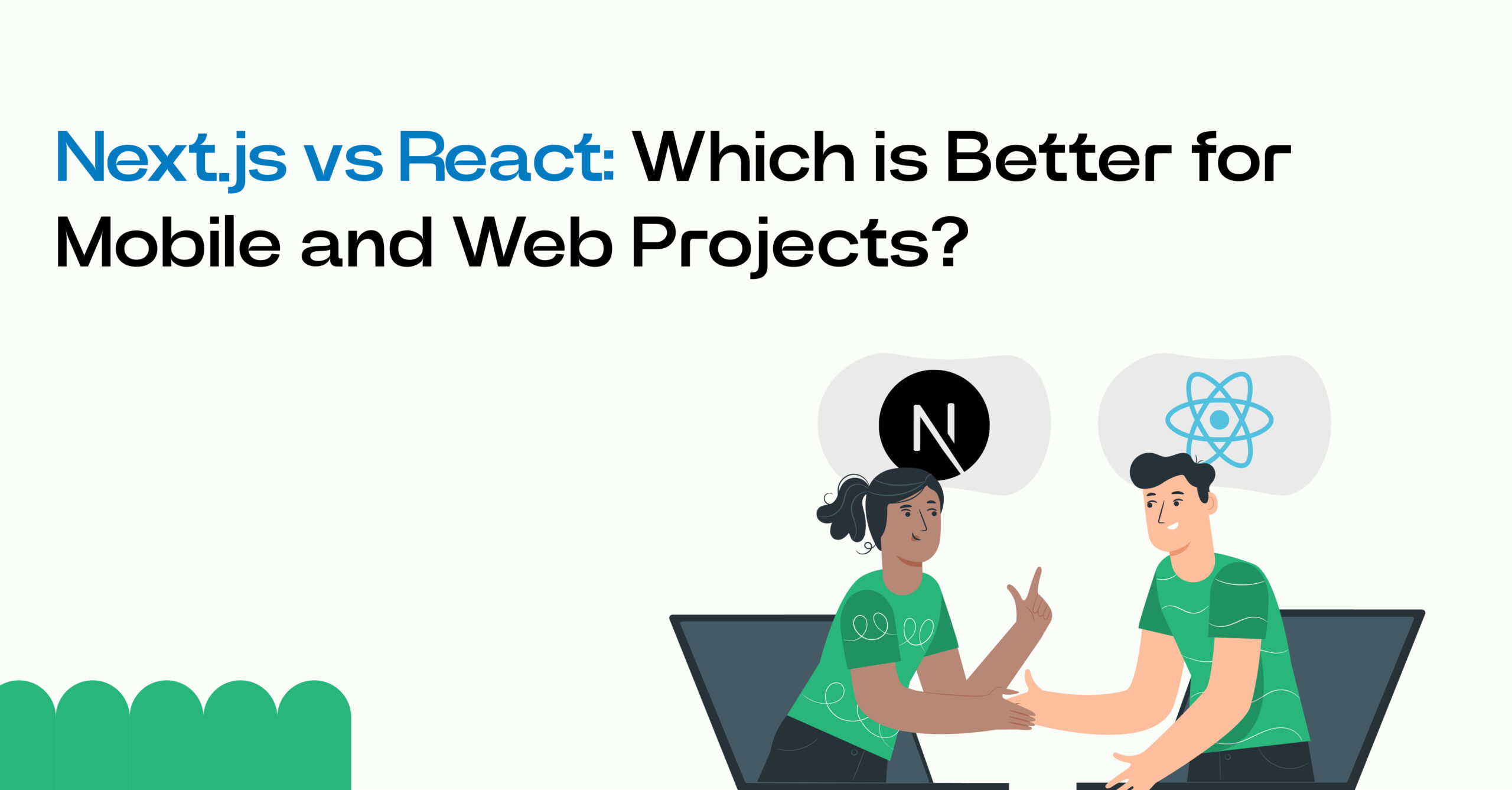Next.js vs React: Which Framework is Right for Your Next Project?

The world of web and mobile app development is rapidly changing and evolving (it’s crazy!), so choosing the right framework is extremely crucial as it can make or break your next big project. Two of the popular and powerful tools right now for the developer are React and Next.js. React is an extremely powerful JavaScript library for building interfaces meanwhile, Next.js is a more robust framework built on top of React, offering more number of features like server-side rendering (SSR) and static site generation (SSG).
But which one to choose? Right? Well in this blog, we will cover all the key differences, use cases, and even the benefits of React and Next.js to help you make a more informed decision. So whether you are building a dynamic web app, an SEO-friendly website, or even a scalable mobile app, this blog has got your back (just like Jack!).
What is React?
React is a JavaScript library developed by Facebook, widely used for building Facebook developed the React on the JavaScript library, widely used for building interactive user interfaces. It’s known for its component-based architecture, which allows developers to create reusable UI components. The React’s virtual DOM ensures efficient rendering, making it a favorite among the developers all around for building single-page applications (SPAs) and dynamic web apps.
Key Features of React
- Component-Based Architecture: Build reusable UI components for faster development.
- Virtual DOM: Ensures high performance by minimizing direct DOM manipulation.
- Strong Ecosystem: A vast library of tools and community support.
- Flexibility: Can be integrated with other libraries and frameworks.
When to Use React
- Building SPAs or dynamic web apps.
- Projects requiring high customizability.
- Teams familiar with JavaScript and React’s ecosystem.
React is widely used by developers for its simplicity and flexibility, making it a top choice for web app development companies and startups alike.
What is Next.js?
Next.js is a React-based framework that takes React’s capabilities to the next level. It’s designed to simplify the development of server-side rendered (SSR) and statically generated (SSG) web applications. With features like file-based routing, API routes, and built-in SEO optimization, Next.js is ideal for building full-stack applications and SEO-friendly websites.
Key Features of Next.js
- Server-Side Rendering (SSR): Improves performance and SEO.
- Static Site Generation (SSG): Pre-renders pages at build time.
- File-Based Routing: Simplifies routing with a file-system-based approach.
- API Routes: Enables backend functionality within the same project.
When to Use Next.js
- Building SEO-friendly web apps.
- Developing full-stack applications.
- Large-scale projects requiring performance optimization.
Next.js is a powerful choice for your next frontend development project, especially if you’re looking for seamless front-end and back-end development.
Key Differences Between Next.js and React
| Aspect | React | Next.js |
|---|---|---|
| Rendering | Client-side rendering (CSR) | Server-side rendering (SSR) and SSG |
| Routing | Manual setup (e.g., React Router) | File-based routing |
| Performance | Efficient for SPAs | Optimized for SSR and large-scale apps |
| Use Cases | SPAs, dynamic web apps | SEO-friendly websites, full-stack apps |
| Learning Curve | Easier to learn | Requires understanding of SSR and SSG |
React Native for Mobile App Development
While React and Next.js are primarily used for web development, React Native is the go-to framework for cross-platform mobile app development. Built on React, React Native allows developers to build native-like mobile apps for both iOS and Android using a single codebase.
Why Choose React Native?
- Cross-Platform Compatibility: Write once, run on both iOS and Android.
- Reusable Components: Share code between web and mobile apps.
- Strong Ecosystem: Access to a wide range of libraries and tools.
React Native is widely used by mobile app development companies for building scalable and high-performance apps.
Next.js vs React Native: Which is Better for Mobile and Web Projects?

- Next.js is ideal for web apps that require SEO optimization, server-side rendering, or full-stack capabilities.
- React Native is the better choice for cross-platform mobile app development, offering native-like performance and reusable components.
For projects that require both web and mobile solutions, many companies opt for a combination of Next.js for web apps and React Native for mobile apps.
Future Trends: React Native and Next.js in 2025
As we look ahead, both React Native and Next.js are expected to dominate their respective domains:
- React Native will continue to grow as a preferred framework for hybrid mobile applications, with advancements in performance optimization and integration with backend frameworks.
- Next.js will likely see increased adoption for full-stack development, thanks to its seamless front-end and back-end capabilities.
Conclusion: Which Framework Should You Choose?
The choice between React and Next.js ultimately depends on your project requirements:
- Choose React if you’re building SPAs, dynamic web apps, or need high customizability.
- Choose Next.js if you’re developing SEO-friendly websites, full-stack applications, or large-scale projects.
- For mobile app development, React Native is the clear winner, offering cross-platform compatibility and native-like performance.
Still unsure which framework is right for your project? Tuvoc Technologies is here to help! As a leading web and mobile app development company, we specialize in custom React Native development services and Next.js development. Whether you’re looking to hire dedicated React Native developers or need expert guidance on your next frontend development project, our team has got you covered.
Ready to get started? Contact Tuvoc Technologies today and let’s bring your vision to life!
FAQs
Next.js is primarily designed for web development, offering features like server-side rendering (SSR) and static site generation (SSG), making it ideal for SEO-friendly websites and full-stack applications. On the other hand, React Native is a cross-platform mobile app development framework that allows developers to build native-like mobile apps for iOS and Android using a single codebase. While Next.js excels in web app development, React Native is the go-to choice for scalable and high-performance mobile apps.
React Native simplifies cross-platform app development by enabling developers to write code once and deploy it on both iOS and Android platforms. Unlike traditional mobile frameworks, React Native uses reusable components, offers native-like performance, and integrates seamlessly with backend frameworks. Its strong ecosystem and community support make it a preferred choice for building scalable and efficient mobile applications.
Next.js provides built-in support for server-side rendering (SSR) and static site generation (SSG), which significantly improve performance and SEO for web applications. Its file-based routing, API routes, and seamless front-end and back-end development capabilities make it a robust framework for building full-stack applications. These features make Next.js a top choice for developers working on large-scale, SEO-friendly, and high-performance web projects.
React Native simplifies cross-platform development by allowing developers to use a single codebase for both iOS and Android apps. Its reusable components, strong ecosystem, and native-like performance make it a cost-effective and time-efficient solution. Additionally, React Native’s integration with backend frameworks and its ability to share code between web and mobile apps further streamline the development process, making it a popular choice for startups and enterprises alike.
Hiring a React Native development company ensures access to experienced developers who specialize in building scalable and high-performance mobile apps. These companies offer expertise in React Native’s ecosystem, performance optimization, and seamless integration with backend frameworks. By leveraging their knowledge, you can reduce development time, ensure cross-platform compatibility, and deliver a native-like user experience, making your app stand out in the competitive market.



